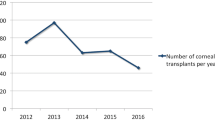Abstract
Background
To evaluate the efficacy of corneal tattooing for various clinical applications.
Methods
The medical charts of 62 eyes of 62 patients who underwent corneal tattooing between March 2016 and August 2017 were retrospectively reviewed. The causes of opacity and various methods of corneal tattooing were analyzed.
Results
Among our 62 patients, 38 were males and 24 were females. Average age was 48.47 ± 15.30 (range, 12–74) years old. The mean follow-up period was 40.19 ± 2.34 (range, 36–43) months. The most common causes of corneal opacity were ocular trauma (33 eyes, 53.2%), prior retinal surgery (9 eyes, 14.5%), congenital etiologies (8 eyes, 12.9%) and measles (5 eyes, 8.0%). The most common associated ocular findings were strabismus (23 eyes, 37.0%), phthisis bulbi (17 eyes, 27.4%) and band keratopathy (13 eyes, 20.9%). Cosmetic outcomes improved without serious complications in all cases.
Conclusions
Corneal tattooing is a viable option with an expanding set of indications, such as discolored previous corneal tattoos, white pupil due to inoperable cataract with clear cornea and dense corneal opacities in blind eyes. Elective corneal tattooing seems to be a viable and convenient method to improve cosmesis with minimal complications and high patient satisfaction.




Similar content being viewed by others
Data availability
The patient data used to support the findings of this study are available from the corresponding author upon request.
Abbreviations
- LP:
-
Light perception
- NLP:
-
No light perception
- BCVA:
-
Best corrected visual acuity
References
George DK, Ide Takeshi, Galor Anat (2009) Femtosecond-assisted anterior lamellar corneal staining-tattooing in a blind eye with leukocorea. Cornea 28:211–213
Mannis MJ, Eghbali K, Schwab IR (1999) Keratopigmentation: a review of corneal tattooing. Cornea 18:633–637
der Velden Van, Samderubun EM, Kok JH (1994) Dermatography as a modern treatment for coloring leucoma corneae. Cornea 13:349–353
Ahn SJ, Han YK, Kwon JW (2009) A case of superficial corneal tattooing for glare after trabeculectomy. Can J Ophthalmol 44:e63
Reed JW (1994) Corneal tattooing to reduce glare in cases of traumatic iris loss. Cornea 13:401–405
Sekundo W, Seifert P, Seitz B, Loeffler KU (1999) Longterm ultrastructural changes in human corneas after tattooing with non-metallic substances. Br J Ophthalmol 83:219–224
Laria C, Alió JL, Piñero DN (2010) Intrastromal corneal tattooing as treatment in a case of intractable strabismic diplopia (double binocular vision). Binocul Vis Strabismus Q 25:238–242
Jo DH, Han YK, Kwon JW (2011) Conjunctival tattooing after evisceration for cosmesis. Can J Ophthalmol 46(2):204–205
Cha DM, Shin KH, Kim KH (2013) Simple keratectomy and corneal tattooing for limbal dermoids: results of a 3-year study. Int J Ophthalmol 6:463–466
Kim C, Kim KH, Han YK (2011) Five-year results of corneal tattooing for cosmetic repair in disfigured eyes. Cornea 30:1135–1139
Jeong Jinho, Song Young-Jin, Jung Seung-Il (2015) New surgical approach for limbal dermoids in children: simple excision, corneal tattooing, and sutureless limboconjunctival autograft. Cornea 34:720–723
Paik JS, Lee YK, Doh SH (2014) A patient with combined corneal and ingrowing conjunctival tissue tattooing by micropigmentation method. J Craniofac Surg 25(2):e170–172
Park JH, Um TW, Kim MJ (2015) A new multiple noncontinuous puncture(pointage) technique for corneal tattooing. Int J Ophthalmol 8:928–932
Lin HC, Wang YL, Chen GW (2016) Corneal tattooing and anterior stromal puncture for treating symptomatic bullous keratopathy. Cornea 35:355–357
Kim JH, Lee D, Hahn TW (2009) New surgical strategy for corneal tattooing using a femtosecond laser. Cornea 28:80–84
Kreidstein ML, Giguere D, Freiberg A (1997) MRI interaction with tattoo pigments: case report, pathophysiology, and management. Plast Reconstr Surg 99:1717–1720
Alio JL, Rodriguez AE, Bahrawy ME (2016) Keratopigmentation to change the apparent color of the human eye: a novel indication for corneal tattooing. Cornea 35:431–437
Acknowledgements
Not applicable.
Funding
None.
Author information
Authors and Affiliations
Contributions
JJ made design for the study, JDF carried out statistical analysis, JKL revised the manuscript, RSC participated in its design and coordination and helped to draft the manuscript, and JWK participated in its design and coordination and helped to draft the manuscript. All authors read and approved the final manuscript.
Corresponding author
Ethics declarations
Conflict of interest
The authors have no other proprietary or commercial interest in any materials discussed in this article. No conflicting relationship exists for any author.
Consent for publication
Patients provided written informed consent after being given a detailed explanation of the study. We confirmed that patients agreed to data publication in a journal.
Ethical approval
The study protocol was in accordance with the Declaration of Helsinki and was approved by the Institutional Review Board of Myongji Hospital, Hanyang University College of Medicine, Seoul, Korea (MIRB 2018-04-003-001). Additionally, written informed consent was obtained from all participants.
Additional information
Publisher's Note
Springer Nature remains neutral with regard to jurisdictional claims in published maps and institutional affiliations.
Rights and permissions
About this article
Cite this article
Jeong, J., Fay, J.D., Lee, J.K. et al. The 3-year outcomes of corneal tattooing for severely disfigured corneas. Int Ophthalmol 40, 1773–1779 (2020). https://doi.org/10.1007/s10792-020-01346-z
Received:
Accepted:
Published:
Issue Date:
DOI: https://doi.org/10.1007/s10792-020-01346-z




